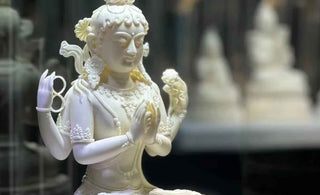
In the realm of Tibetan statue craftsmanship, the application of vibrant colors takes center stage, transforming these divine embodiments into captivating works of art. The meticulous artistry involved in painting Tibetan statues involves a profound engagement with mineral pigments, creating a visual symphony that resonates with spiritual symbolism and cultural richness.
Mineral pigments, sourced from the earth's treasures, become the palette through which artisans breathe life into inert materials. The choice of pigments is not arbitrary; each hue carries symbolic significance deeply rooted in Buddhist iconography. The vivid colors used in Tibetan statues serve as visual metaphors, transcending the merely aesthetic to convey profound spiritual teachings.
The process begins with the priming of the statue's surface, creating a canvas ready to absorb the rich pigments that will soon adorn it. Artisans, often trained in age-old techniques passed down through generations, skillfully mix mineral pigments with binders such as water, glue, or oil. This careful concoction ensures the longevity and adherence of the colors to the statue's surface.
The color palette itself is a testament to the reverence for tradition and spirituality. Earthy ochres, serene blues, regal reds, and calming greens are chosen not merely for their visual appeal but for the stories they tell. Gold leaf, often reserved for highlighting sacred features, adds a luminous touch, symbolizing the divine radiance associated with enlightened beings.
In the intricate world of Tibetan statues, the application of gold leaf stands as a transcendent art form, and a shining example is the revered "Golden Tara of Palcho Monastery." The choice of gold leaf in this masterpiece is not merely a decorative flourish but a deliberate and sacred act. As the artisans meticulously affix thin sheets of gold onto the surface, they are engaged in a symbolic dialogue with divinity.
The "Golden Tara" is a manifestation of the goddess Tara, a Bodhisattva embodying compassion and enlightened activity. Each delicate stroke of gold leaf enhances the divine aura surrounding Tara, transforming the statue into a luminous beacon of spiritual presence. The gold, representing purity and enlightenment in Tibetan Buddhism, transcends its material form to become a visual manifestation of the Buddha's teachings.
The process of gilding the Tara involves a meticulous application, as if the artisans are channeling the divine energy onto the statue's surface. The gold leaf, with its ethereal glow, accentuates the serene expressions of Tara and illuminates the intricate details of her adornments. The delicate features of the deity become more than artistic expression; they become conduits for spiritual contemplation.
Beyond the aesthetic allure, the use of gold leaf symbolizes the enlightened qualities that Tara embodies. The luminosity of gold mirrors the inner radiance cultivated through compassion, wisdom, and selfless action—fundamental tenets of Tibetan Buddhism. As light plays upon the gilded surface, it invites devotees to reflect on the transformative power of these teachings in their own lives.
In the quiet halls of Palcho Monastery, the "Golden Tara" becomes a living testament to the harmonious marriage of artistic mastery and spiritual devotion. The interplay of gold leaf and divine symbolism transcends mere craftsmanship; it becomes a sacred offering, an homage to the timeless wisdom encapsulated in Tibetan Buddhism. The "Golden Tara," with its resplendent gold leaf, beckons observers into a realm where art and spirituality converge, inviting them to contemplate the boundless possibilities of enlightenment.
As the artisans delicately apply the pigments, they navigate the contours of the statue with precision and devotion. Each stroke is an act of homage to the spiritual essence the statue represents. The iconographic details, whether intricate facial expressions, celestial garments, or auspicious symbols, are brought to life through the skillful use of color.
The symbolism embedded in the colors goes beyond mere aesthetics. White, representing purity, grace, and the teachings of the Buddha, adorns the robes of enlightened beings. Deep blues and rich reds, reminiscent of the sky and sunset, symbolize the vastness of wisdom and the boundless compassion of Bodhisattvas. Greens, associated with fertility and the natural world, connect the divine with the earthly realm.
Beyond the visual feast, the application of mineral pigments becomes a meditative practice for the artisans. The act of painting a Tibetan statue is not merely a surface-level endeavor; it is an intimate dialogue with the sacred. The colors become conduits, translating the spiritual narratives into a language accessible to the eyes.
The final result is more than a painted statue; it is a vibrant testament to the synthesis of art and spirituality. The interplay of colors on the surface mirrors the intricate dance between form and formlessness, materiality and transcendence—a core tenet of Buddhist philosophy. Each stroke becomes a brushstroke of wisdom, inviting observers to contemplate the profound teachings encapsulated in the visual narrative.
Conclusion
In conclusion, the art of painting Tibetan statues with mineral pigments is a celebration of color as a carrier of culture, spirituality, and ancient wisdom. It is a living tradition that breathes vibrancy into the static forms, inviting those who engage with these statues to embark on a visual journey through the realms of divinity. The captivating colors, sourced from the earth's embrace, become not only a feast for the eyes but a doorway to the rich tapestry of Tibetan spirituality.

Qing Dynasty Four Armed Tara Copper Mineral Color Palpung Monastery
























